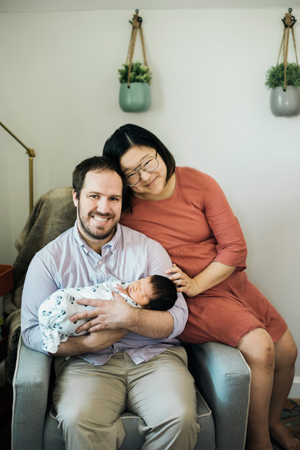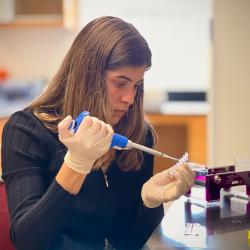From the Marines to Medicine: Meet UMD Undergraduate Colton Treadway
A veteran of the U.S. Marines, Treadway plans to study genetic diseases caused by misfolded proteins after graduation
Colton Treadway—a triple major in physics, chemistry and biological sciences at the University of Maryland—says that a teacher at Broadneck High School in Annapolis, Md. showed him the joys of physics.
 “Mr. Leitner taught physics and ran the physics club,” Treadway said. “He held a contest where we designed and built cars powered by mousetraps, and my team won for ‘fastest acceleration.’ It was so much fun.”
“Mr. Leitner taught physics and ran the physics club,” Treadway said. “He held a contest where we designed and built cars powered by mousetraps, and my team won for ‘fastest acceleration.’ It was so much fun.”
Treadway loved that physics could explain how the world worked. So in 2008, he followed in Leitner’s footsteps and took secondary education courses at California University of Pennsylvania to become a physics teacher.
Within a year, Treadway knew he did not want to teach high school for the rest of his life. When he saw former President Barack Obama announcing the withdrawal of troops from Iraq, Treadway saw this as an opportune time to accomplish his goal of serving his country in wartime.
“I come from a military family—my parents and brother all served—and I always wanted to serve during wartime,” Treadway said. “When I saw President Obama’s announcement, I thought, ‘I better go now.’”
After he enlisted in the U.S. Marines in 2010, Treadway deployed to Afghanistan as a mortarman—a Marine who specializes in operating artillery weapons. During his training, one of his favorite experiences was receiving combat lifesaving training in emergency medical procedures from a Navy corpsman. Treadway learned to pack wounds, apply tourniquets and insert an IV line.
“We were all a bit nervous about deploying,” Treadway said. “Having that training made us feel a little safer, even though I never ended up using it. I still know how to put in an IV line, although of course I wouldn’t be allowed to do it anymore.”
That medic training eventually made Treadway realize that wanted to become a doctor.
“I discovered that I wanted to help people outside of a military context,” Treadway said. “When I thought about the Navy corpsman who trained me, I realized that medicine was a good way to do that.”
Once Treadway returned home after serving four years, he began researching universities and discovered that UMD offered excellent pre-med and physics programs, which was important because he remained interested in physics. Staying in Maryland also allowed him to remain close to family and friends.
On top of that, UMD provided financial assistance to supplement his GI Bill educational benefits. Treadway received the College of Computer, Mathematical, and Natural Sciences’ Corcoran Inspiration Scholarship—which was created by dentist Paul Corcoran (B.A. ’68, sociology) to assist nontraditional students such as veterans. Treadway also received the Avis and Bruce Richards Endowed Veterans Scholarship through Veteran Student Life. In 2018, he received support from the National Science Foundation Scholarships in Science, Technology, Engineering, and Mathematics Program through the Department of Physics.
Thanks to the financial support he received, Treadway could focus on his studies and spend time conducting research.
In 2016, his friend Stacey Mannuel—a bioengineering major—heard about a contest to send an experiment to the International Space Station (ISS). When she asked if Treadway wanted to collaborate on a proposal, he said yes.
“We actually had the same idea for the proposal,” Treadway said. “We both somehow watched the same video of bacteria evolving antibiotic resistance on a giant petri dish. We thought that was really cool and it gave us the idea to study biofilms in space.”
Treadway and Mannuel wrote a proposal to explore the effects of microgravity on biofilms, which are slimy layers of bacteria that adhere to each other and to virtually any surface. They were overjoyed when they won the contest and their experiment was chosen to fly to the ISS. However, after spending months preparing and sending their experiment to the ISS, they experienced something most scientists have encountered: failure.
“Stacey tested the sample that came back from space,” Treadway said. “She found that the bacteria didn’t grow at all. Our experiment didn’t work and we have no idea why.”
Treadway said the failure taught him what real-life science is like.
“It really showed me that it’s possible that you can learn everything and plan everything, and the experiment is still not going to work,” Treadway said.
But Treadway didn’t give up on research after the failed experiment. Instead, he joined the biophysics laboratory of Arpita Upadhyaya, an associate professor of physics, to pursue his fascination of how complex biological concepts could be broken down into their basic mathematical and physical components. In Upadhyay’s lab, Treadway studied how immune system cells sense pressure differences.
“I observed other laboratory members developing an experimental protocol pretty much from scratch,” Treadway said. “I learned that something as ‘simple’ as chemically treating cells for an experiment could take months of work to develop. It really taught me just how much time and effort goes into research.”
Now, Treadway’s sights are set on a different topic in biophysics that directly impacts medicine: how protein molecules fold into their correct 3D shapes.
“After I took a class on how incorrectly folded proteins can lead to diseases such as cystic fibrosis, it gave me a direction to go in with medicine that matches my interest in physics and chemistry,” Treadway said. “For instance, developing a drug that fixes a misfolded protein requires understanding the chemical and physical energy involved in protein folding..”
After he graduates in May 2019, Treadway plans to conduct research on protein folding and misfolding for a year or two before attending medical school.
“I would love to design a method to correct misfolded proteins that cause genetic diseases, while treating patients with such diseases,” Treadway said.
###
Media Relations Contact: Irene Ying, 301-405-5204, zying@umd.edu
University of Maryland
College of Computer, Mathematical, and Natural Sciences
2300 Symons Hall
College Park, MD 20742
www.cmns.umd.edu
@UMDscience
About the College of Computer, Mathematical, and Natural Sciences
The College of Computer, Mathematical, and Natural Sciences at the University of Maryland educates more than 9,000 future scientific leaders in its undergraduate and graduate programs each year. The college’s 10 departments and more than a dozen interdisciplinary research centers foster scientific discovery with annual sponsored research funding exceeding $175 million.







